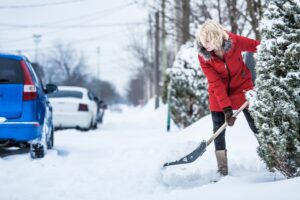
Many people who shovel snow don’t exercise regularly. Grabbing a shovel to move around hundreds of pounds of snow, if you’ve been doing nothing for several months, can strain your heart, as can pushing around a heavy snowblower.
The weather doesn’t necessarily help, either. Cold weather can boost blood pressure, interrupt blood flow to the heart, and increase the likelihood of blood clots.
Shoveling snow can present a heart attack risk.
The signs of a heart attack are squeezing pain in the chest, shortness of breath, pain radiating up the left shoulder or down the left arm, or a cold sweat. They can also include jaw pain, lower back pain, and unexplained fatigue or nausea.
You can make snow shoveling a little safer by doing the following:
Warming up muscles before starting. This may not significantly impact your heart, but it can help prevent injury. Move around a bit to get some blood flowing to help you limber up.
Don’t rush. Shovel light loads instead of heavy ones and take frequent breaks. It may result in a little more time, but it may help you protect your health.
Drink plenty of water. Staying well hydrated in the winter can help keep your blood thin, so it circulates easier and puts less strain on your heart.
Dress in layers. You’ll likely work up a sweat, but that doesn’t mean you’ll want to take your hat off or open your jacket to expose a t-shirt. You still want to keep warm and protect yourself from frigid temperatures, even if you don’t think you’re that cold. If you open or remove a parka, you’ll want another warm layer underneath, like a fleece or sweatshirt.
Remember that you don’t have to remove every snowflake from your property. The priorities are the walkways you use most frequently – like the pathway from front door to your vehicle. Clearing the snow from behind the vehicle, as well.
Remember to salt to melt any ice, as well.
Shoveling snow is a fact of life for many in North America, but don’t take its health risks lightly. If you need help, call a service, family member, or neighbor.
And if you feel dizzy or lightheaded while shovelling, or notice other physical changes, stop immediately.